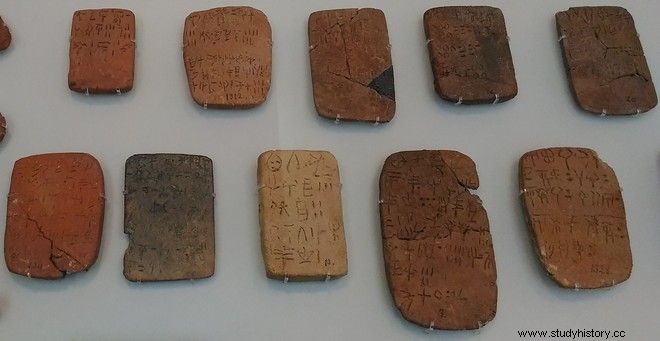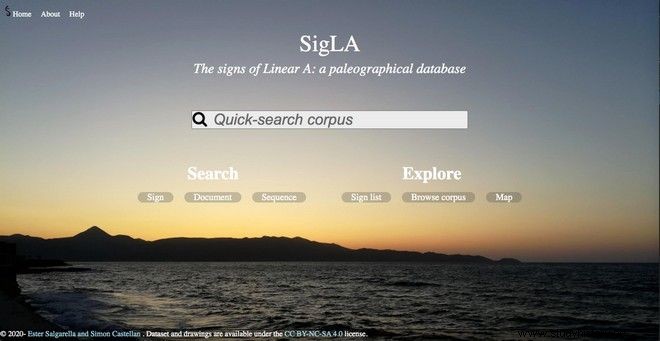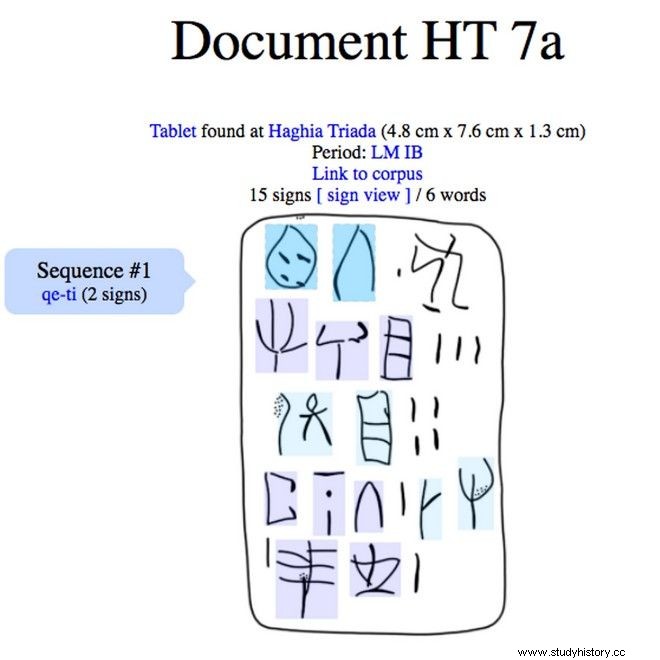Can modern technology help decipher Linear A, the Minoan script that still holds its secrets well? Dr. Ester Salgarella, a researcher at St John's College, Cambridge, not only believes so but also attempts it with the open access database SigLA (https://sigla.phis.me/), which she built in collaboration with computer scientist Dr. Simon Castellan from the University of Rennes in France. SigLA includes a list of 300 standard symbols from 400 Linear A inscriptions hand-copied by the researcher. The database is still under construction, but more than 3,000 individual symbols found in the inscriptions are searchable.

“SigLA displays Linear A inscriptions in an interactive database where users can clearly see and identify individual symbols (syllabograms, logograms, trade marks, whether a symbol is simple or complex), as well as words and word boundaries. Before SigLA, this knowledge was limited to experts, who made the identifications themselves, given that the only published collection (corpus) of Linear A inscriptions does not have phonetic transcriptions of the texts," says Ms. Salgarella to APE-MPE, explaining that for every text in Linear A that appears in SigLA there is an online link to the scanned pages of the corpus, which have been made available on the Internet by its publishers, namely the French School of Athens.

In addition, the database allows advanced paleographical searches to be performed which are filtered by a set of parameters. "In this way, the data is adapted to each user's research needs. We hope that all these searches and flexibility in reorganizing the data will eventually help to 'crack' the code", adds the researcher, emphasizing however that "'deciphering' means understanding the language encoded in a writing, as well as the of its linguistic link, if it can be identified. Therefore, for now we can 'read' the Linear A script, but we cannot yet understand it," notes Dr. Salgarella, dealing with the relationships between the Aegean scripts of the Bronze Age, i.e. Cretan Hieroglyphs (ca. 1900 – 1600 BC), Linear A (ca. 1800/1700 – 1450 BC) and Linear B (ca. 1400/1370 – 1190 BC).
"Of these, only the Linear B script has been deciphered as the oldest known written form of the Greek language, while the language (or languages) behind the other two scripts remains to be determined. In my research I use an interdisciplinary approach combining archaeological, epigraphic and palaeographical analysis and unifying the resulting data," he points out. She even proceeded to publish a monograph entitled Aegean Linear Script(s):Rethinking the Relationship Between Linear A and Linear B.
"My monograph focuses on the 'tradition of Linear writing'. It examines the transmission of writing and the adaptation of the process from the pattern of Linear A to Linear B. I approached the two scripts from a structural and palaeographical perspective, which means that on the one hand I analyzed the structural features of both writing systems (i.e., typology and function symbols) and on the other I investigated their graphic symbol 'repertoire' (symbol shapes and variations) in order to assess the level of 'debt' that Linear B has to Linear A. The structural analysis revealed that the way the two scripts organize and they use the symbols differ to a certain extent, mainly in relation to the conceptual function of the symbols", he explains to APE-MPE.

However, palaeographic research has shown that, on a purely graphic level, the resemblance is much stronger than originally thought. "By studying the palaeographic variants (i.e., graphic symbol shapes, graphic variants and their distribution in locations that produced Linear A elements), both in each script separately and in comparison with each other, it became possible to observe that several symbol variants in Linear B already had a graphic antecedent to Linear A. This suggests that there was no strong standardization in symbols during the transmission of writing in terms of its graphic form, without implying that modifications did not occur, as they did. However, the script remained almost unchanged in its overall graphic outline. This is also the reason why I chose 'Script(s)' as the title of my monograph - which is deliberately ambiguous (s.s. i.e. writing or writings)", he adds. The palaeographical research allowed her to observe something also important:"Inscriptions of Linear A found in places north and northeast of Crete (mainly Chania, Archanes and Zakros) show the greatest graphic similarity with the inscriptions of Linear B. This could indicate that Linear B developed under the graphic influences of Linear A which was in use on the north and north-eastern coasts of Crete", Ms. Salgarella informs APE-MPE.

But why is Linear A so difficult to decipher? “In total, written evidence in Linear A script amounts to about 1,400 inscriptions, which is not particularly impressive, especially compared to Linear B, for which we have about 6,000 inscriptions. So the first problem is the fairly small existing data set – furthermore, most inscriptions are fragmentary or in a poor state of preservation. The second problem is that most of the inscriptions are short and formal in nature (short records of financial transactions), without much syntax appearing, which does not help to identify the grammatical structure of the language. Thirdly, we do not have a bilingual text that could help us to correctly identify the semantic meaning of the words. All these reasons together make it difficult for now to recognize the language encoded in Linear A", he answers us.
As for how likely he considers the decipherment of Linear A, he adds:"As I mentioned above, a number of obstacles do not allow us to decipher Linear A. Although we can 'read' the inscriptions in Linear A using some phonetic values that we have for Linear B, we cannot understand its symbols. Until this is done, the writing remains 'unencrypted'. Great progress can be achieved with interdisciplinary analysis and the help of modern technology:We need collaborations between scholars working in different fields in order to use as many different and complementary approaches as we can. SigLA can help in this regard, but it is not the 'magic genie lamp'. We need to create tools to further investigate the features of the inscriptions as well as the underlying language – unless we eventually find a bilingual text", concludes APE-MPE.
Follow News247.gr on Google News and be the first to know all the news
Read the News from Greece and the world, with the reliability and validity of News247.gr
